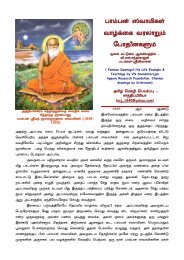MALAYSIAN HINDU PILGRIMAGE: KAVADI ... - Murugan Bhakti
MALAYSIAN HINDU PILGRIMAGE: KAVADI ... - Murugan Bhakti
MALAYSIAN HINDU PILGRIMAGE: KAVADI ... - Murugan Bhakti
Create successful ePaper yourself
Turn your PDF publications into a flip-book with our unique Google optimized e-Paper software.
to undergo rigorous austerities and sacrifice in the service of that deity. In turn the pilgrim knows thatthe deity will acknowledge and respond to that devotion (Moronis).<strong>KAVADI</strong> WORSHIP IN MALAYSIAThe individual decision to bear a kavadi may be prompted by a number of factors including penance,spiritual unfoldment, overcoming unfavourable karma, or all of these, but in most instances isundertaken to honour a vow. Stereotypically, those fulfilling a vow have entered a reciprocal contractwith <strong>Murugan</strong>, a sort of “cosmic bargaining” as it were, in which the devotee has agreed to bear akavadi over a given period provided a certain request is fulfilled e.g. recovery from an illness, theconception and successful delivery of a child, reconciliation within a family. Often those who takekavadis are inspired by spirit mediums who advise them of misfortunes, contracted in this and pastlives, which have cast a blight upon them personally, or upon their families.At Batu Caves, kavadi bearers are drawn from the entire spectrum of Malaysian Hindu society. Indeedmy own fieldwork corroborates the observation of Simons et al, (p. 269) who indicated that thesubjects of the study “…ranged in age from 12 years to over 50 and we equally divided as to sex. Theycame from all socio-economic levels and educational backgrounds, and included unepmployed youths,college students, labourers and businessmen.” Thaipusam, ostensibly a Tamil festival, now drawsHindus from every regional Indian background represented in Malaysia, as well as Sikhs, members ofMalaysia’s miniscule Sinhalese community, and Chinese devotees.Those who would bear a kavadi must in effect enter a period of renunciation and asceticism, severalweeks of ritual purification which will prepare them for their encounter with the deity. This involvescessation of many daily activities as well as adherence to strict disciplines. Collectively theseobservances place the devotee outside the normative boundaries of life as a grihastya (householder),and temporarily into the category of sannyasin. In metaphorically removing the aspirant from mundanetime and space, these restrictions mark the devotee as a “pilgrim”, one who has embarked upon thefirst stages of the tirtha-yatra. Ideally purificatory rites should extend over 48 days, but many devoteesobserve lesser periods, and experienced participants may fast for as little as seven days.Some devotees may move into a temple or another acknowledged holy place for the final few days oftheir fast. Many intending kavadi bearers attend what is known as a trial trance. Trial trance is usuallyconducted in a single session, but sometimes over a number of sessions, within the small suburban orvillage and estate temples. The major aim of trial trance is to train the devotee to achieve and sustaintrance, and thus to withstand the distractions he/she will experience on Thaipusam day when the trancestate and bodily piercing which follow must be conducted in the full glare of public scrutiny.On Thaipusam eve aspirants gather at prearranged sites, either at one of the small temples within thenearby Indian settlement, or at designated meeting places on the lawns within the Batu Cavescompound, or along the riverbank adjacent to the Caves complex. Devotees will generally be dressedin yellow clothes with red edgings (both colours traditionally associated with <strong>Murugan</strong>) shorts orvesthis for men, saris or “Punjabi suits” (consisting of a loose baju (shirt) and slacks) for women. OnThaipusam day devotees will also wear anklets which jingle rhythmically as they dance, and some willattach small bells to their kavadis and belts.Over the next few hours, in an atmosphere increasingly charged with anticipation and exhilaration,(perhaps tempered in the case of novices by an all too tangible foreboding), devotees will completecongeries of purificatory rites. In many groups some or most of these rites may be bypassed and somevillage communities observe only the initial propitiatory puja to Ganesha, whose permission as Rulerof Obstacles must be sought before embarking upon the most intense stages of the pilgrimage. At theculmination the devotees are summoned one by one to the group leader. He/she is asked if he/sherealizes the full significance of the vow he/she has taken, that a yellow thread is about to be tied aroundhis/her right wrist, and that from that time onwards he/she will not be permitted to leave the temple ordesignated sacred area until he/she is fitted with the kavadi. (This period may be a matter of minutes orhours depending upon circumstances.) The thread is then tied.Immediately prior to the final set of pre-kavadi rituals, the aspirant takes a ceremonial purificatorybath. This is done while fully clothed. The devotee takes at least three full buckets/dippers of running


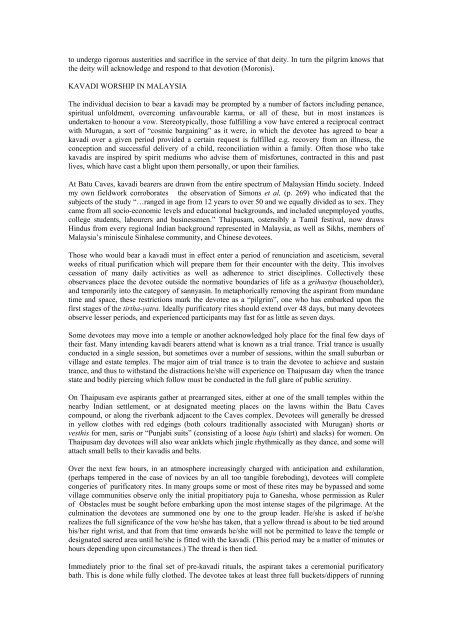

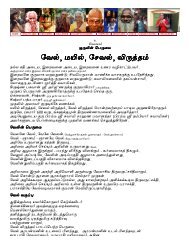

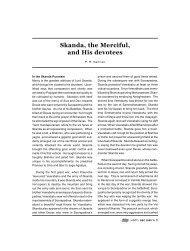

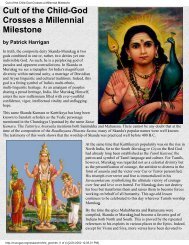
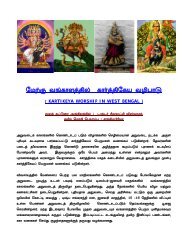
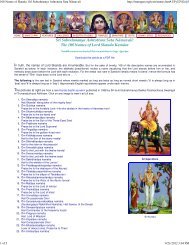
![gHdp k]y Myaj;jpw;F ghj ahj;jpiu fpuhkpa gHf;f Kiwfs;](https://img.yumpu.com/10245948/1/184x260/ghdp-ky-myajjpwf-ghj-ahjjpiu-fpuhkpa-ghff-kiwfs.jpg?quality=85)

